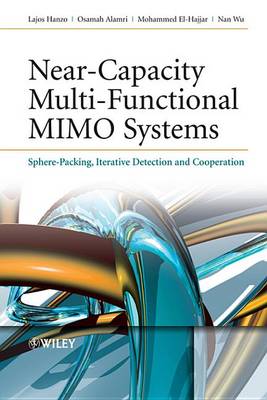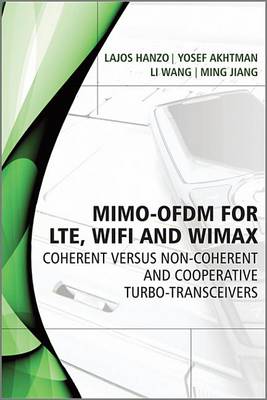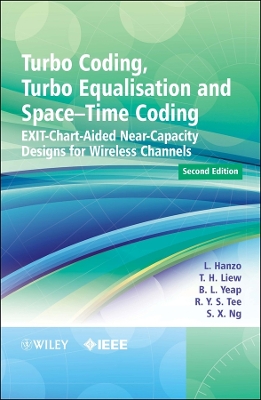Wiley - IEEE
3 primary works • 6 total works
Book 4
Near-Capacity Multi-Functional MIMO Systems
by Lajos Hanzo, Osamah Alamri, Mohammed El-Hajjar, and Nan Wu
Sophisticated amalgam of five year's near-capacity MIMO research* Detailed examination of wireless landscape, including the fields of channel coding, spacetime coding and turbo detection techniques* Novel tool of Extrinsic Information Transfer Charts (EXIT) used to address recent developments* Material presented logically, allowing advanced readers to turn directly to any specific chapter of interest* One of the only books to cover these subjects, giving equal weighting to each
Book 24
Near-Capacity Variable-Length Coding
by Lajos Hanzo, Robert G. Maunder, Jin Wang, and Lie-Liang Yang
* Surveys the historic evolution and development of VLCs * Discusses the very latest research into VLC codes * Introduces the novel concept of Irregular VLCs and their application in joint-source and channel coding
Book 26
MIMO-OFDM for LTE, WiFi and WiMAX
by Lajos Hanzo, Yosef Akhtman, Li Wang, and Ming Jiang
This monograph collates the latest techniques in a number of specific design areas of turbo-detected MIMO-OFDM wireless systems. As a result a wide range of topical subjects are examined, including channel coding and multiuser detection (MUD), with a special emphasis on optimum maximum-likelihood (ML) MUDs, reduced-complexity genetic algorithm aided near-ML MUDs and sphere detection. The benefits of spreading codes as well as joint iterative channel and data estimation are only a few of the radical new features of the book.
Also considered are the benefits of turbo and LDPC channel coding, the entire suite of known joint coding and modulation schemes, space-time coding as well as SDM/SDMA MIMOs within the context of various application examples. The book systematically converts the lessons of Shannon's information theory into design principles applicable to practical wireless systems; the depth of discussions increases towards the end of the book.
- Discusses many state-of-the-art topics important to today's wireless communications engineers.
- Includes numerous complete system design examples for the industrial practitioner.
- Offers a detailed portrayal of sphere detection.
- Based on over twenty years of research into OFDM in the context of various applications, subsequently presenting comprehensive bibliographies.
Turbo Coding, Turbo Equalisation and Space-Time Coding
by Lajos Hanzo, T. H. Liew, B. L. Yeap, R. Y. S. Tee, and Soon Xin Ng
The book also elaborates on turbo equalisation by providing a detailed portrayal of recent advances in partial response modulation schemes using diverse channel codes. A radically new aspect for this second edition is the discussion of multi-level coding and sphere-packing schemes, Extrinsic Information Transfer (EXIT) charts, as well as an introduction to the family of Generalized Low Density Parity Check codes. This new edition includes recent advances in near-capacity turbo-transceivers as well as new sections on multi-level coding schemes and of Generalized Low Density Parity Check codes * Comparatively studies diverse channel coded and turbo detected systems to give all-inclusive information for researchers, engineers and students * Details EXIT-chart based irregular transceiver designs * Uses rich performance comparisons as well as diverse near-capacity design examples
OFDM and MC-CDMA for Broadband Multi-User Communications, WLANs and Broadcasting
by Lajos Hanzo, M. Munster, Byungcho Choi, and Thomas Keller
Divided into three main parts: Part I provides a detailed exposure of OFDM designed for employment in various applications Part II is another design alternative applicable in the context of OFDM systems where the channel quality fluctuations observed are averaged out with the aid of frequency--domain spreading codes, which leads to the concept of MC--CDMA Part III discusses how to employ multiple antennas at the base station for the sake of supporting multiple users in the uplink* Portrays the entire body of knowledge currently available on OFDM* Provides the first complete treatment of OFDM, MIMO(Multiple Input Multiple Output)--OFDM and MC--CDMA* Considers the benefits of channel coding and space time coding in the context of various application examples and features numerous complete system design examples* Converts the lessons of Shannon's information theory into design principles applicable to practical wireless systems* Combines the benefits of a textbook with a research monograph where the depth of discussions progressively increase throughout the book This all--encompassing self--contained treatment will appeal to researchers, postgraduate students and academics, practising research and development engineers working for wireless communications and computer networking companies and senior undergraduate students and technical managers.



